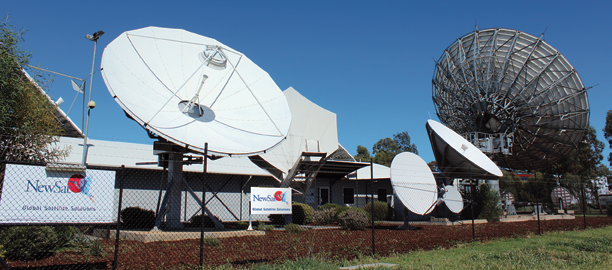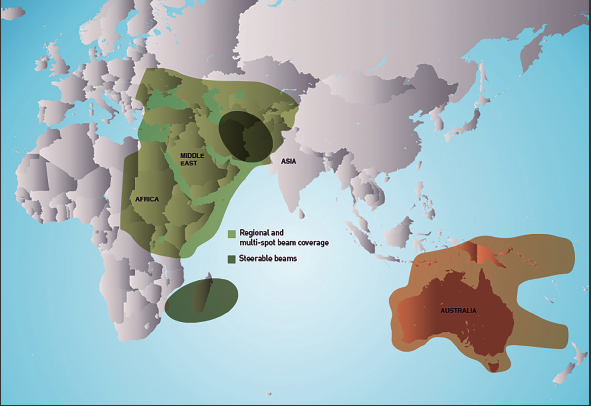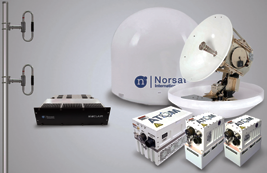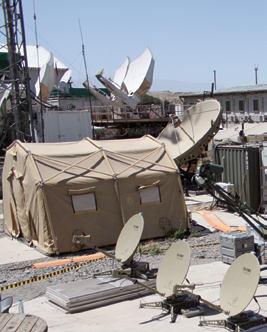By Diego Paldao, Vice President, EMEA and Americas
Comprised of multiple nations, the unique Asia Pacific (APAC) region has become a significant driver of global economic growth—2013 saw the global economy expand by 2.4 percent, of which 45 percent originated in the East Asia Pacific, while growth for the entire region in 2014 and 2015 has been projected at 5.4 and 5.5 respectively (IMF, 2013).

With resilient, growing and emerging economies and a rising middle class, progressive trade agreements, increased deregulation and globalization as well as being home to the world’s busiest international sea and air routes, Asia Pacific is a center of global activity.
This activity has paralleled with military expansion from countries further abroad having a military presence in the region; whether for border protection, disaster relief, or supporting international peacekeeping and humanitarian action. In spite of decreasing military expenditure which has been felt across the entire satellite industry, the need for innovative communications solutions remains with an increased reliance on voice, data, and Internet connectivity to perform day-to-day tasks as well as enhance activity, such as navigation signaling and unmanned aerial vehicles (UAV’s).
Connectivity is an essential element of daily tasks and mission critical operations, increasing bandwidth requirements for military. In NSR’s Government and Military Satellite Communications, 11th Edition, Northern Sky Research, the forecasts for demand from the global government and military market will reach more than 750 transponders by 2023, an increase of 54 percent from 2013. Transponder and capacity revenues will more than double, reaching $2,120 million in 2023, from $850 million in 2013. Driven by evolving bandwidth-hungry applications, as well as rising demand for ISR applications, UAVs, VoIP and video conferencing, NSR forecasts a return to overall market growth by the end of 2016.

NewSat’s Adelaide, Australia, teleport.
“The military’s focus on mobility applications, especially using UAVs and manned aeronautical platforms for ISR missions, will boost demand for both FSS and HTS COMSATCOM capacity. Revenues from various mobility applications will represent 90 percent of the managed service market and 50 percent of leased capacity totals over the next decade,” said Brad Grady, Senior Analyst at NSR.
Grady also stated that the ubiquitous nature of satellite over an area as geographically diverse as APAC means this is the preferred platform in the delivery of fast, reliable and secure communications and this will only intensify, highlighting the vital role of satellite communications and the importance of available satellite capacity.
Carolyn Belle, also a NSR Analyst, added, “...governments will be more reliant on their own MILSATCOM satellites moving forward, but they lack sufficient capacity to meet demand—compatible commercial capacity will remain a necessary component of solving that disparity.” As such, the satellite industry is evolving to provide new capacity and developing associated technologies to do so in today’s growing markets.
The push for more capacity in the sky is driving change on the ground, as operators aim to meet the unique requirements of the sector. NSR forecasts that multiband equipment and interoperable terminals that allow users to switch to military capacity when necessary will be sought after as well as UAV command and control links for secure communications, which will constitute a larger market as more units enter service (NSR, 2014).
However, an essential element is the teleport selected to support the network. Teleports that were once basic satellite uplink facilities are now more likely to be the hubs of dozens—or even hundreds—of overlapping complex networks. Many pieces of the network are now connected from the ground, increasing the importance of having a secure teleport. This is especially true for military communications which must be secure, a vital element necessary to ensure the success of critical missions.

NewSat’s Jabiru-1 and Jabiru-2 coverage map.
Uniquely situated in regard to technological, geographical and skill based standpoints to provide world-class commercial and operational support services, as well as being a secure partner in APAC, NewSat owns and operates two Australian teleports that are located in Perth and Adelaide. These two teleports offer a full range of teleport and satellite services, with coverage to 75 percent of the globe; from Australia, Asia, the Middle East, Africa, across the Indian Ocean extending into Europe and across the Pacific Ocean, reaching into the West Coast of the USA.
NewSat’s teleports already support crucial elements of government and military global communications and will provide further support with the company’s first satellite, Jabiru-1, Australia’s first commercial Ka-band satellite. Jabiru-1 will deliver more than 7.6GHz of “new” capacity, providing high-powered Ka-band coverage to meet the growing demands from government and enterprise sectors across the Middle East, Asia and Africa.
NewSat has started the expansion of the Adelaide teleport which will host the Jabiru Satellite Control Facility and Jabiru Customer Support Centre for Jabiru-1.
Jabiru 1 will have flexible Ka-band capacity that can support both land and littoral missions in and around East Africa and will enable additional connectivity to Diego Garcia. This capacity was specifically designed to be used by ally nations, including the U.S. [As a strong U.S. ally the Australian Defence Force (ADF) has a long standing relationship of cooperation with the U.S. Armed Forces , which includes the use of ADF facilities around Australia.] Further, the U.S. Navy’s Triton UAV platform which will use Ka-band capacity to provide real-time ISR over vast ocean and coastal regions, which will be particularly applicable for the Gulf and the horn of Africa where Jabiru-1 will provide coverage.
With the changes in government and military requirements, the need for satellite capacity availability remains a constant. NewSat partnered with MEASAT to host their Jabiru-2 payload, which launched in September of 2014. The Ku-band satellite provides fresh capacity to satisfy the increasing communication requirements in and around Australia, as well as Papua New Guinea, Timor Leste and the Solomon Islands, with highly concentrated bandwidth enabling high-quality communications to support mission critical communications.
Other satellites include SES 9, set to launch in 2015, which features expansive mobility beams designed for airliners and ships traveling through the APAC region. Particular focus will be for the Indian Ocean, while SES 12, which is scheduled to launch in 2017, will address government markets in Asia and will include the first SES HTS payload.
HTS will play an important role in the government and military uptake of commercial satellite capacity. Driven by the lower cost per bit and enhanced throughput availability, the expected capacity demand for HTS will reach 75.5Gbps, up from 1.3Gbps in 2013, with a CAGR of 51 percent (NSR, 2014).
Fresh capacity from such satellites will ensure the connectivity required for innovative and bandwidth heavy applications is available upon demand across government and military sectors. The availability of high-powered satellite capacity to provide more efficient solutions is essential for the continued military presence and future government requirements within the region.
Looking ahead, secure, cost-effective and managed services over bulk leasing will be essential in addressing the evolving operating constraints. As the APAC region continues its global dominance across a number of sectors and economic growth, government and military sectors, satellite communications will play a most crucial role in ensuring the safety and security of the region.
Diego Paldao has more than 14 years’ experience in the satellite industry. His initial exposure to satellites was with UUNET providing IP transit services. His team worked closely with satellite operators to provide connectivity via satellite for areas that were lacking in sufficient or stable fiber connectivity. Following this role, Diego joined global teleport operator, Verestar, which was acquired by SES Americom (USA). He has held various positions within SES’ multiple business units, supporting enterprise and government clients based in North America. Diego joined NewSat in January 2012 and is responsible for supporting all commercial and government clients in the Americas and EMEA regions.
By Dr. Amiee Chan, President and Chief Executive Officer
Norsat is a leader in providing innovative customizable communications solutions for the military and government sectors through our three business units: Sinclair Technologies, Satellite Solutions and Microwave products.

During 2014, Norsat launched several new products ideal for military applications including land-based and airborne Communications-On-The Move (COTM) and unmanned aerial vehicles. In April, Norsat launched the ATOM series Ku-Band Block Up converters (BUCs) and Solid State Power Amplifiers (SSPAs). These BUCs and SSPAs are among the industry’s smallest, lightest, and most power efficient available in the market, making them ideal for portable applications.
Throughout 2014, we completed deliveries of the new line of ATOM products to Harris Corporation and other customers in the defense sector. Norsat has achieved several design wins for airborne terminals, manned and unmanned vehicles in 2014 and our ATOM series of BUCs and amplifiers are flying in multiple UAVs today. Norsat will continue to expand the ATOM product line in 2015 offering additional bands and power capabilities.

With growing world challenges, we are seeing a higher demand for increased data rates and rapid communications in the theater of operation. The military has been engaged in discussions about the use of Ka-band for some time given its high throughput capabilities.
Satellite programs such as the WGS constellation, O3b and Inmarsat Global Express are proof that the market is ready for Ka-band for military and commercial communications. In the course of 2014, Norsat delivered several new Ka-band products, both LNB’s and BUC’s, to help our customers take advantage of the Ka opportunity.

From our satellite terminal line, a significant design win to note is our recent award to provide X-Band marine VSAT (very small aperture terminal) units for use in a naval fleet. The units are built to withstand high impact shocks and vibrations that occur on military vessels. Throughout 2014, Norsat was also awarded contracts from several of our customers from around the world to design and deliver custom portable terminals from our leading edge GlobeTrekker, Rover and SigmaLink design platforms.
Norsat continues to execute a balanced growth strategy that incorporates new product development, continued enhancement of existing product lines, greater diversification by geographic region as well as by industry verticals. Specifically we are investing in research and development and testing to ensure that our products meet the stringent military specifications, such as RTCA-DO-160, MIL-STD-810 and MIL-STD461, required for robust, reliable communications.
Operationally, we continue to maintain a strict cost discipline across our operations while ensuring we invest in R&D for future growth. To drive ongoing efficiencies, we balance cost reductions with strategic investment throughout our operations. We have also ramped up our LEAN manufacturing initiatives in order to streamline our material process and to continually improve our operational efforts, which aids in quicker delivery times.

In Afghanistan, pictured are the Dual-band Auto-acquire Rapiddeployable Terminals (DART).
Our recently announced third quarter financials are showing solid revenue growth with a 20+ percent increase in sales of our microwave components, which is mainly driven by deliveries of our new ATOM series of products. We continue to receive strong interest in the ATOM product line and believe it will continue to provide long-term growth for years to come. We are extremely pleased that Norsat ended the third quarter with a net positive cash position; the company’s first in nearly four years. We anticipate that we will finish strong in the fourth quarter and our revenue is on track with our expectations.
Norsat will continue to work closely with our military customers to ensure that new products we launch can be tailored to meet their specific needs and will operate long term in military-type applications.
Norsat continues to diversify its business by broadening its product portfolio and the pursuit of strategic acquisitions, as well as expanding its customer base on a geographic basis in order to lead growth for the company in the future.
Founded in 1977, Norsat International Inc. provides innovative communication solutions that enable the transmission of data, audio and video for remote and challenging applications. Norsat’s products and services include leading-edge product design and development, production, distribution and infield support and service of fly-away satellite terminals, microwave components, antennas, Radio Frequency (RF) conditioning products, maritime based satellite terminals and remote network connectivity solutions.
The company’s products and services are used extensively by telecommunications services providers, emergency services and homeland security agencies, military organizations, health care providers, news organizations and Fortune 1000 companies. Customers include NATO, the United States Department of Defense, Marine Corps, Army, Navy and Air Force; FOX News, CBS News; Boeing, Reuters, Motorola, TESSCO, General Dynamics and others.

The company’s corporate office is located in Richmond, British Columbia, Canada and has offices in Aurora, Ontario, Canada, Hamburg, New York and Lincoln and Somersham, England.
Dr. Amiee Chan has more than 15 years of experience in executive management and research & development in the telecommunications industry. Offering a rare blend of technical and corporate strength, Dr. Chan’s strategic vision has driven Norsat’s innovative product development program and resulted in consistent revenue growth since her appointment as CEO in 2006.
Prior to joining Norsat, Dr. Chan worked at Creo Inc. where she guided the company through multiple product developments, beta programs, rollout strategies and product launches. Her strategic approach to business was reflected in the growth of Creo’s $80 million consumables product division. Dr. Chan currently holds three U.S. patents in satellite technologies and has been involved in high level research teams such as the NASA ACTS Terminal Program.
Dr. Chan holds an Executive MBA from Simon Fraser University where she majored in Strategy & New Ventures, as well as an Electrical Engineering Ph. D. in Satellite Communications from the University of British Columbia. Dr. Chan currently serves on the Dean’s External Advisory Board for the Beedie School of Business at SFU, the Science World Board of Directors and the UBC Engineering Advisory Council. Dr. Chan currently resides in Vancouver with her husband and two children.
By Carolyn Belle, Analyst
Within the diversity of space-based activities and services, the interplay between commercial industry and the government/military forms a collection of relationships and evolving roles. As we reach the end of 2014, communications services stands out as the most challenged of these commercial—government relationships and associated markets.

Many governments rely on commercial operators for communications capacity when they do not have access to, or have exceeded, proprietary supply. Except in cases when the state cannot be clearly delineated from commercial activities, commercial players do not use government space communications assets. Yet the communications market is far more inter-connected than this fact suggests: due to the high ARPUs and relative market size of government and military communications, commercial industry has an established reliance on government and military revenues. This reality has hardly been more apparent than in 2014. Indeed, this year many operators and service providers made public their lowered financial performance forecasts as a result of weak U.S. government SATCOM markets.
Balancing Demand: The government and military communications market is governed by an intricate array of supply and demand elements. Not only must two sources of supply be considered (MILSAT and COMSAT), but inconsistency in demand complicates hope for a stable market. NSR sees three primary factors impacting government/military COMSAT acquisitions:
1. Sustained demand: The prioritization of remote communications capabilities, both in the scope of overall distribution of government spending and in military spending. This element controls the total amount and type of procurement.
2. Spiking demand: Geopolitical events that draw nations into conflict and/or assistance in distant regions of the globe.
3. Throttle: Government and military budgets related to the macroeconomic situation and internal policies.
While the first factor remained strong in 2014, waning geopolitical drivers for capacity demand and generally worsening budgets hampered market performance. On balance, 2014 was a weak year for the government and military COMSATCOM market—the second year of decline in what is expected to be a multi-year slump.
2014 Challenges: First and foremost, the ongoing budget decrease—especially in the U.S., traditionally the largest COMSATCOM market—impacted the ability of government and military agencies to follow through on desired equipment and commercial capacity procurements. Commercial players fought to maintain profits in the resulting absence of few new programs or orders and more re-competition on previously won contracts for existing programs. Further, the evolving move of satellite operators into sub-markets traditionally the niche of service providers heightened competition. Such an environment led to reductions in transponder pricing to win contracts, meaning tight and in some cases negative margins. Over the 2013-2014 period, workforce reductions and restructuring were implemented as a means of countering the impact of such revenue declines on the bottom line.
Meanwhile, the U.S. government’s ability to address their own demand with proprietary satellites rose: MUOS-2, AEHF-3, WGS-5, and
WGS-6 were all launched in 2013, coming into general use in 2014. Space segment additions extended to Europe in 2014, with the launch of Italian-French Athena-Fidus and Sicral 2/Syracuse III c satellites. Given the perception of proprietary satellites as providing “paid-for” capacity, and in the context of limited budgets, the pressure to prioritize use of such assets and turn to commercial capacity only as a secondary source increased. Especially as compatible terminals are fielded and remaining WGS satellites are launched, NSR sees this as a consistently growing dynamic over the next 5 years.
The continued withdrawal of U.S. and NATO forces from Afghanistan directly reduced demand for capacity in the Middle East with an associated negative impact on commercial players. Yet just as U.S. and NATO engagement in Iraq and Afghanistan spiked demand for COMSATCOM in the early 2000s, the eventual withdrawal of such forces and a corresponding drop in demand was anticipated. While maintenance of foreign presence through the September 2014 Bilateral Security Agreement will generate enduring demand over the next couple years, it will not be more than a fraction of the peak demand seen in 2011 and 2012.
2014 Successes: The most notable successes in 2014 have been a willingness to leverage advancements in technology and growing acceptance of varied commercial roles in the formation of diversified space architectures.
The extension of high bandwidth services to lower levels of command (company level in addition to brigades and battalions) opened the door to new sources of equipment and service demand. Complemented by the establishment of new programs of record such as the U.S. Transportable Tactical Command Communications, and the ongoing fielding of smaller on-the-pause terminals (e.g. SNAP-Lite) and on-the-move terminals, this reaffirmed the importance of SATCOM connectivity in tactical military operations.
Long awaited services debuted with government and military user tests in 2014, including Ka-band GEO-HTS through Inmarsat-5/Global Xpress and MEO-HTS through O3b. The appearance and expanded availability of new products, including Wi-Fi hotspot devices from multiple MSS operators and L-TAC from Inmarsat, has broadened the utility of satellite services for military, civil government, and NGO markets.
Industry has long advocated for an extension of leasing periods to beyond one year in duration, and the June 2014 award of the first multi-year U.S. Air Force Pathfinder contract to SES Government Solutions heralded preliminary results. While questions regarding the utility of the inclined Ku-band capacity leased for regional military users remain, an RFP for a second Pathfinder contract was announced several days later. The pace at which this, and the future 4, Pathfinder contracts are awarded and implemented will determine the true impact of this program on the procurement process as a whole.
The associated hope and concern of disaggregation remained an industry buzzword in 2014. The July 2014 Hosted Payload Solution (HoPS) contracts signaled a willingness to explore potential mission advantages and cost savings through a streamlined approach. U.S. and foreign militaries also continued to experiment with nano satellites as communications platforms to complement existing assets. Nonetheless, and while such actions are positive, sweeping changes to the current space architecture and mode of operation will be complicated and time-intensive to implement – in essence, unlikely to impact the market materially in the near-term.

2015 Expectations: NSR believes that 2015 will not be a significant or watershed year in the COMSATCOM market. The restraints of 2014 will continue nearly unabated. The impact of ongoing budget restrictions will be amplified by further launches of military satellites and associated leaps in available proprietary capacity. Far fewer troops will be actively deployed in Afghanistan in 2015, though emerging hostilities against Islamic State/ISIS and potential for escalating conflict in Eastern Europe could augment demand; as a commercial capacity play, the associated use of UAV and manned aeronautical platforms in such arenas will drive demand to commercial operators.
Ka-band GEO-HTS and MEO-HTS services are expected to progress to operational use following testing.
In 2015 and beyond, the market will experience a rising focus on applications and services—ISR, VoIP, and video conferencing—as well as mobility. While these areas are not anticipated to cultivate market growth in 2015, the ongoing development of demand and diversification of available solutions will provide a foundation for market upswing in 2016.
Uncertainty Lingers: Given the series of key demand variables identified above, it is critical to consider the government and military SATCOM market through the lens of several possible futures. Potential for a shifting political balance in key countries, emergence of unexpected geopolitical crises, and still fluctuating budgetary levels could all impact the amount and distribution of overall SATCOM procurement worldwide.
Will NATO engage in a third ground-based military intervention in the Middle East, with a consequential demand for surge capacity? Might the 2016 U.S. election raise the Republican Party to Executive and Legislative power, bringing with it a stronger focus on defense-related spending? Or, could U.S. sequestration worsen and force even deeper spending reductions than expected?
Following the 2013-2014 declines, the government and military satellite communications market is approaching a crossroad. The many factors at play in the kinds and amounts of commercial SATCOM procurement could go in several of many directions, reinforcing NSR’s belief that the state of this market is far less certain than many commercial players might like.
Bottom Line: Overall, 2014 was a down year for the government and military commercial satellite communications market and an exacerbation of the negative trend noted in 2013. While the government and military appetite for remote communications capabilities is not expected to decline moving forward, financial resources to procure such capacity are lacking in the near-term. As government budgets increase, new services are adopted, and methods of procurement are modernized to increase efficiencies, there is more hope that the government and military SATCOM market will return to growth.
Ms. Belle joined NSR as an analyst with several years of experience in the space industry, ranging from atmospheric chemistry to education outreach and market research. Her main focus is satellite manufacturing and launch markets, and in particular the trends surrounding creation of diversified space architectures. She also contributes to research in government and military communications markets in addition to participating in the diverse tailored consulting projects undertaken at NSR.
Ms. Belle comes to NSR from the Research and Analysis team at the Space Foundation, where her research efforts primarily addressed new and emerging space products and services as well as the policy considerations and efficacy of international space endeavors such as the International Space Station. Ms. Belle received a Master’s degree in Space Management from the International Space University.


